Invacare POC1-100C, POC1-100B User Manual
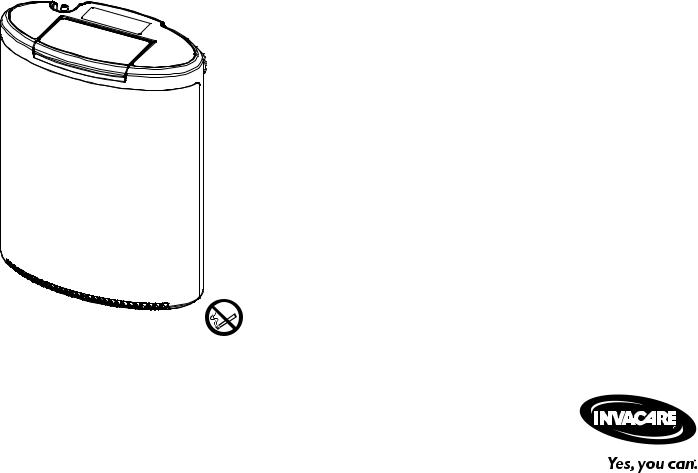
Invacare® Platinum® Mobile
POC1-100B, POC1-100C
en Oxygen Concentrator User Manual
This manual MUST be given to the user of the product.
BEFORE using this product, this manual MUST be read and saved for future reference.
©2018 Invacare Corporation
All rights reserved. Republication, duplication or modification in whole or in part is prohibited without prior written permission from Invacare. Trademarks are identified by ™ and ®. All trademarks are owned by or licensed to Invacare Corporation or its subsidiaries unless otherwise noted. Platinum is a registered trademark in the U.S.A., Europe and Australia.
Making Life’s Experiences Possible is a registered trademark in the U.S.A. Pine-sol, Lestoil and Clorox are registered trademarks of The Clorox Company. Dawn is a registered trademark of The Procter and Gamble Company.
IOS is a trademark or registered trademark of Cisco in the U.S. and other countries and is used under license to Apple, Inc.
Android is a trademark of Google, LLC.
Bluetooth is a registered trademark of Bluetooth SIG, Inc.

Contents
1 General . . . . . . . . . . . . . . . . . . . . . . . . . . . . . . . . . . . . . . . . . 5
1.1 Quick Start Guide . . . . . . . . . . . . . . . . . . . . . . . . . . . . . . 5
1.2 Symbols . . . . . . . . . . . . . . . . . . . . . . . . . . . . . . . . . . . . . 9
1.3 Indications For Use . . . . . . . . . . . . . . . . . . . . . . . . . . . . . 11
1.4 Intended Use . . . . . . . . . . . . . . . . . . . . . . . . . . . . . . . . . 11
1.5 Contraindications. . . . . . . . . . . . . . . . . . . . . . . . . . . . . . . 11
1.6 Features . . . . . . . . . . . . . . . . . . . . . . . . . . . . . . . . . . . . . 12
1.6.1 Control Panel. . . . . . . . . . . . . . . . . . . . . . . . . . . . . . . 12
1.6.2 Input/Output Connections . . . . . . . . . . . . . . . . . . . . . 13
1.6.3 Filters . . . . . . . . . . . . . . . . . . . . . . . . . . . . . . . . . . . . 13
1.6.4 Power Options . . . . . . . . . . . . . . . . . . . . . . . . . . . . . . 14
1.6.5 Carry Bag. . . . . . . . . . . . . . . . . . . . . . . . . . . . . . . . . . 14
1.7 Optional Accessories and Replacement Parts . . . . . . . . . . 14
2 Safety . . . . . . . . . . . . . . . . . . . . . . . . . . . . . . . . . . . . . . . . . . 15
2.1 Label Locations . . . . . . . . . . . . . . . . . . . . . . . . . . . . . . . . 15 2.2 General Guidelines . . . . . . . . . . . . . . . . . . . . . . . . . . . . . 17 2.3 Radio Frequency Interference . . . . . . . . . . . . . . . . . . . . . 22 2.4 Traveling with the Concentrator. . . . . . . . . . . . . . . . . . . . 22
3 Setup. . . . . . . . . . . . . . . . . . . . . . . . . . . . . . . . . . . . . . . . . . . 25
3.1 Unpacking. . . . . . . . . . . . . . . . . . . . . . . . . . . . . . . . . . . . 25 3.2 Inspection . . . . . . . . . . . . . . . . . . . . . . . . . . . . . . . . . . . . 25 3.3 Powering the Oxygen Concentrator . . . . . . . . . . . . . . . . . 25 3.3.1 Installing the Battery(s) . . . . . . . . . . . . . . . . . . . . . . . 26 3.3.2 Charging the Battery(s). . . . . . . . . . . . . . . . . . . . . . . . 27
3.3.3 Reading the Battery Gauge for Installed and
Uninstalled Battery(s) . . . . . . . . . . . . . . . . . . . . . . . . 28 3.3.4 Removing the Battery(s). . . . . . . . . . . . . . . . . . . . . . . 29 3.3.5 External AC Power . . . . . . . . . . . . . . . . . . . . . . . . . . . 30 3.3.6 External DC Power . . . . . . . . . . . . . . . . . . . . . . . . . . . 30 3.4 Carry Bag Setup . . . . . . . . . . . . . . . . . . . . . . . . . . . . . . . 31 3.4.1 Installing the Carry Bag . . . . . . . . . . . . . . . . . . . . . . . 31 3.4.2 Removing the Carry Bag. . . . . . . . . . . . . . . . . . . . . . . 32
3.4.3 Installing Shoulder Straps . . . . . . . . . . . . . . . . . . . . . . 32 3.5 Connecting/Positioning the Nasal Cannula . . . . . . . . . . . . 33
4 Usage . . . . . . . . . . . . . . . . . . . . . . . . . . . . . . . . . . . . . . . . . . 35
4.1 Location . . . . . . . . . . . . . . . . . . . . . . . . . . . . . . . . . . . . . 35 4.2 Concentrator Operating Position . . . . . . . . . . . . . . . . . . . 35 4.3 Using the Carry Bag . . . . . . . . . . . . . . . . . . . . . . . . . . . . 35 4.4 Turning On the Concentrator . . . . . . . . . . . . . . . . . . . . . . 36 4.5 Turning Off the Concentrator. . . . . . . . . . . . . . . . . . . . . . 37 4.6 Warm Up Period . . . . . . . . . . . . . . . . . . . . . . . . . . . . . . . 37 4.7 Breathing with the Use of the Concentrator. . . . . . . . . . . 37 4.8 Reading the Display Screen . . . . . . . . . . . . . . . . . . . . . . . 37 4.9 Adjusting the Pulse Flow Setting . . . . . . . . . . . . . . . . . . . 38 4.10 Battery Life and Management . . . . . . . . . . . . . . . . . . . . 39
5 Maintenance . . . . . . . . . . . . . . . . . . . . . . . . . . . . . . . . . . . . . 41
5.1 Maintenance . . . . . . . . . . . . . . . . . . . . . . . . . . . . . . . . . . 41 5.2 Service Life . . . . . . . . . . . . . . . . . . . . . . . . . . . . . . . . . . . 41 5.3 Cleaning the Cabinet . . . . . . . . . . . . . . . . . . . . . . . . . . . . 41 5.4 Cleaning the Air Intake Filter Screen . . . . . . . . . . . . . . . . 42 5.5 Cleaning the Carry Bag . . . . . . . . . . . . . . . . . . . . . . . . . . 42 5.6 Cleaning and Disinfection Between Patients . . . . . . . . . . . 43 5.7 Viewing Hour Meter . . . . . . . . . . . . . . . . . . . . . . . . . . . . 44 5.8 Preventative Maintenance Checklist . . . . . . . . . . . . . . . . . 45
6 After Use . . . . . . . . . . . . . . . . . . . . . . . . . . . . . . . . . . . . . . . . 47
6.1 Storage . . . . . . . . . . . . . . . . . . . . . . . . . . . . . . . . . . . . . . 47 6.2 Disposal . . . . . . . . . . . . . . . . . . . . . . . . . . . . . . . . . . . . . 47 6.3 Wear and Tear . . . . . . . . . . . . . . . . . . . . . . . . . . . . . . . . 48
7 Troubleshooting . . . . . . . . . . . . . . . . . . . . . . . . . . . . . . . . . . . 49
7.1 Troubleshooting . . . . . . . . . . . . . . . . . . . . . . . . . . . . . . . 49 7.2 Alarm Conditions. . . . . . . . . . . . . . . . . . . . . . . . . . . . . . . 51 7.2.1 Operational Alarms . . . . . . . . . . . . . . . . . . . . . . . . . . 52 7.2.2 Shut Down Alarms . . . . . . . . . . . . . . . . . . . . . . . . . . . 60
8 Technical Data . . . . . . . . . . . . . . . . . . . . . . . . . . . . . . . . . . . . 65
8.1 Technical Description. . . . . . . . . . . . . . . . . . . . . . . . . . . . 65 8.1.1 Pneumatic Diagram . . . . . . . . . . . . . . . . . . . . . . . . . . 65
8.2 Specifications . . . . . . . . . . . . . . . . . . . . . . . . . . . . . . . . . 66
8.3 Regulatory Listing . . . . . . . . . . . . . . . . . . . . . . . . . . . . . . 70
8.4 Electromagnetic Compliance (EMC) . . . . . . . . . . . . . . . . . 71
9 Warranty . . . . . . . . . . . . . . . . . . . . . . . . . . . . . . . . . . . . . . . . 76
9.1 Limited Warranty . . . . . . . . . . . . . . . . . . . . . . . . . . . . . . |
76 |
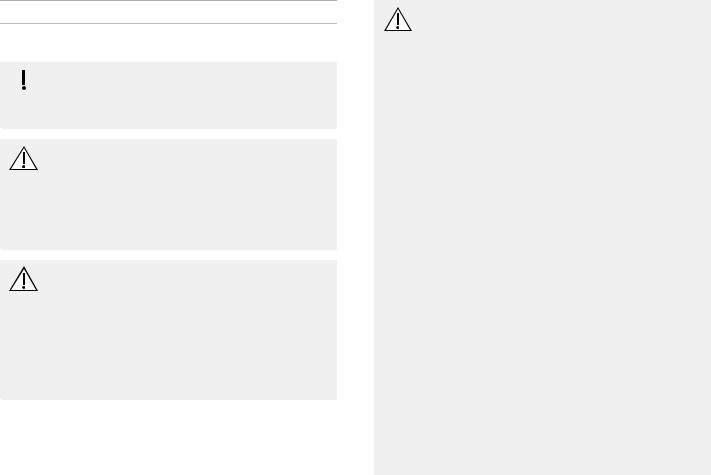
1 General
1.1 Quick Start Guide
IMPORTANT!
– The Quick Start Guide is for reference ONLY. It is imperative to read the manual in its ENTIRETY for full instructions.
DANGER!
Risk of Death, Injury, from Electric Shock
To reduce the risk of burns, electrocution, death or injury to persons:
–DO NOT disassemble. Refer servicing to qualified service personnel. There are no user serviceable parts.
WARNING!
Risk of Injury or Damage
Use of this product outside of the intended use and specifications has not been tested and may lead to product damage, loss of product function, or injury.
–DO NOT use this product in any way other than described in the specifications and intended use sections of this manual.
General
DANGER!
Risk of Death, Injury Or Damage From Fire
Textiles, oil or petroleum substances, grease, greasy substances and other combustibles are easily ignited and burn with great intensity in oxygen enriched air and when in contact with oxygen under pressure. Smoking during oxygen therapy is dangerous and is likely to result in burns or death. To avoid fire, death, injury or damage:
–DO NOT SMOKE while using this device. DO NOT use near OPEN FLAME or IGNITION SOURCES.
–NO SMOKING signs should be prominently displayed.
–Avoid creation of any spark near oxygen equipment. This includes sparks from static electricity created by any type of friction.
–Use only oxygen compatible water-based lotions or salves before and during oxygen therapy. To verify, refer to the lotion/salve container for oxygen compatible water-based statement. If necessary, contact the manufacturer. DO NOT use any lubricants on concentrator unless recommended by Invacare.
–Keep the oxygen tubing, cord, AC adapter, and concentrator out from under such items as blankets, bed coverings, chair cushions, clothing, and away from heated or hot surfaces including space heaters, stoves, and similar electrical appliances.
–Make sure concentrator is off when not in use.
1194969-C |
5 |

Invacare® Platinum® Mobile
DANGER!
Risk Of Death, Injury Or Damage
Improper use of the product may cause death, injury or damage. This section contains important information for the safe operation and use of this product.
–DO NOT use this product or any available optional equipment without first completely reading and understanding these instructions and any additional instructional material such as user manuals, service manuals or instruction sheets supplied with this product or optional equipment.
–If you are unable to understand the warnings, cautions or instructions, contact a health care professional, dealer or technical personnel before attempting to use this equipment.
–Check ALL external components and carton for damage. In case of damage, or if the product is not working correctly, contact a technician or Invacare for repair.
–This product is intended to be used by adults only after reading and understanding the instructions and warnings of this user manual.
–THE INFORMATION IN THIS DOCUMENT IS SUBJECT TO CHANGE WITHOUT NOTICE.
6 |
1194969-C |
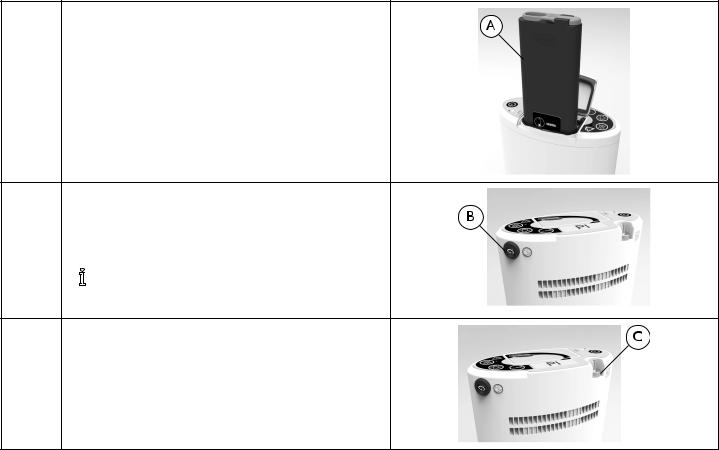
General
1.Open the battery compartment door. With battery
fuel gauge label facing toward the front of the oxygen concentrator, slowly lower battery A straight down into one of the two slots in the battery compartment.
Refer to Installing the Battery(s) in Setup.
2.Connect the AC Power Adapter to the external power input connector B. Plug the AC cord into the electrical outlet.
Refer to External AC Power in Setup.
Using the concentrator for the first time requires the battery(s) to be charged. Refer to Charging the Battery(s) in Setup.
3.Connect the nasal cannula to the concentrator oxygen outlet port on your concentrator C. Oxygen will only be delivered while you are breathing through the nasal cannula connected to this device.
Refer to Connecting/Positioning the Nasal Cannula in Setup.
1194969-C |
7 |
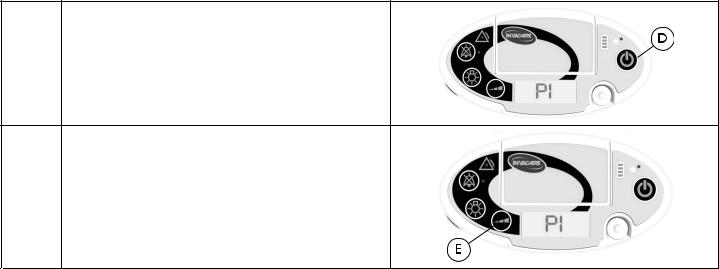
Invacare® Platinum® Mobile
4.Turn on the concentrator by pressing the On/Off Button D until the control panel indicators light up.
Refer to Turning on the Concentrator in Usage.
5.Adjust the pulse flow setting to the one prescribed by your clinical professional. The pulse flow setting can be changed by pressing the flow selection button E. Place the nasal cannula over your ears and position the prongs in your nose as instructed by your health care provider.
Refer to Adjusting the Pulse Flow Setting in Usage.
8 |
1194969-C |
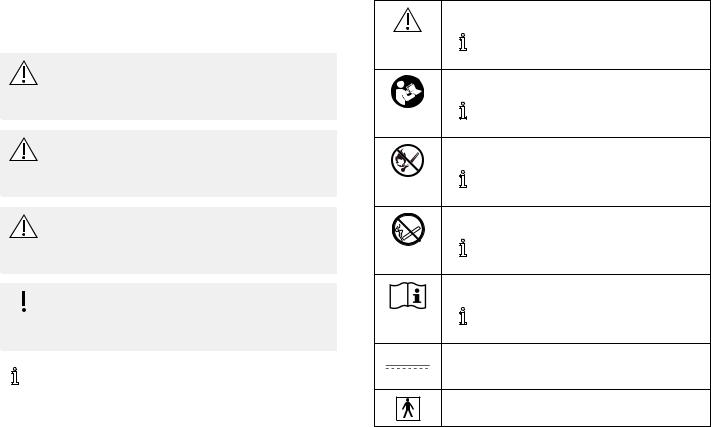
1.2 Symbols
Signal words are used in this manual and apply to hazards or unsafe practices which could result in personal injury or property damage. Refer to the information below for definitions of the signal words.
DANGER!
– Danger indicates an imminently hazardous situation which, if not avoided, will result in death or serious injury.
WARNING!
– Warning indicates a potentially hazardous situation which, if not avoided, could result in death or serious injury.
CAUTION!
– Caution indicates a potentially hazardous situation which, if not avoided, may result in property damage or minor injury or both.
IMPORTANT!
– Important indicates a hazardous situation that could result in damage to property if it is not avoided.
Gives useful tips, recommendations and information for efficient, trouble-free use.
General
Refer to the following table for the meaning of symbols marked on the equipment and/or packaging.
General Warning Sign
The background color inside the triangle is yellow on product labels.
Follow Instructions for Use
The color of the symbol background is blue on product labels.
No open flame
The color of the circle with diagonal bar is red on product labels.
DO NOT Smoke
The color of the circle with diagonal bar is red on product labels.
Consult Instructions for Use
This symbol is located on the cannula packing.
Direct Current
Type BF Applied Part
1194969-C |
9 |

Invacare® Platinum® Mobile
Class II Equipment
Power On/Off
Data Output Terminal
DO NOT dispose of in household waste
Manufacturer
Date of Manufacture
Recycle
Reference Number
Serial Number
DO NOT Reuse (Single Patient Use Only)
This symbol refers to the cannula which is for single patient use only.
Latex Free
Indoor Use ONLY
This symbol is included on the AC power adapter.
DO NOT use oil or grease
Keep dry
Protected against solid foreign objects of 12.5 mm diameter and greater.
Protected against vertically falling water drops when enclosure tilted up to 15°.
Protected against solid foreign objects of 12.5 mm diameter and greater.
Protected against vertically falling water drops.
Transport and Storage Temperature
Transport and Storage Humidity
Electrical Safety Agency Certification Mark
10 |
1194969-C |

1.3 Indications For Use
The Invacare® Platinum® Mobile Oxygen Concentrator is intended to provide supplemental oxygen to patients with respiratory disorders. The device can be used in a home, institution, vehicle, or other environments outside the home.
The Invacare Mobile Medical Application Accessory POC1-CONNECT is intended for use with the Invacare Platinum Mobile Oxygen Concentrator POC1-100B or POC1-100C device, to allow patients via their Android™ or iOS™ mobile phone or tablet to display device settings, and to collect device performance and usage information for maintenance/servicing purposes only.
1.4 Intended Use
The Invacare® Platinum® Mobile Oxygen Concentrator is intended to provide supplemental oxygen to patients with respiratory disorders. The Invacare® Platinum® Mobile Oxygen Concentrator can be used in a home, institution, vehicle, or other environments outside the home. The device is not intended to be life-supporting or life-sustaining.
The Invacare Mobile Medical Application Accessory POC1-CONNECT is intended to allow patients via their Android or iOS mobile phone or tablet to display device settings, and to collect device performance and usage information for maintenance/servicing purposes only.
General
WARNING!
Risk of Injury or Damage
Use of this product outside of the intended use and specifications has not been tested and may lead to product damage, loss of product function, or personal injury.
–DO NOT use this product in any way other than described in the specifications and intended use sections of this manual.
1.5Contraindications
WARNING! Risk of Injury
This product is to be used as an oxygen supplement and is not intended to be life-supporting or life-sustaining. ONLY use this product if the patient is capable of spontaneous breath, able to inhale and exhale without the use of a machine
–DO NOT use in parallel or series with other oxygen concentrators or oxygen therapy devices.
1194969-C |
11 |
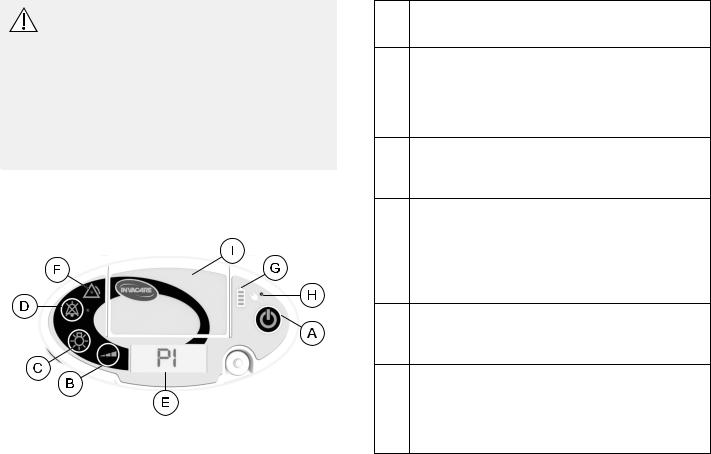
Invacare® Platinum® Mobile
WARNING!
Risk of Minor Injury or Discomfort
The conserving, or pulse dose, oxygen delivery technique used by this device is contraindicated in persons whose breathing during normal resting would be unable to trigger the device.
–Proper device triggering, setup and operation must be confirmed by an experienced clinician or other respiratory professional.
–Not for pediatric use.
–Not for use by tracheotomized patients.
1.6Features
1.6.1 Control Panel
On/Off Button
A
Press for one second to turn concentrator on or off.
Flow Selection Button
Press to adjust the pulsed oxygen flow to your
Bprescribed setting. The selected flow setting is shown on the display screen. Refer to Adjusting the Pulse Flow Setting in Usage for more details.
Display Backlight Button
CPress once to illuminate the display screen for 5 seconds.
Audio Off Button
Press to mute the audible signal (beep) for both
Dalarms and status indications. The blue indicator light next to the button illuminates when activated. Audio off can be activated during or prior to an alarm condition occurring.
Display Screen
EDisplays information about the operating status of the concentrator.
Alarm Indicator
The yellow indicator light at the center of the
Ftriangular symbol illuminates to indicate abnormal operating conditions. Refer to Alarm Conditions in Troubleshooting for more details.
12 |
1194969-C |
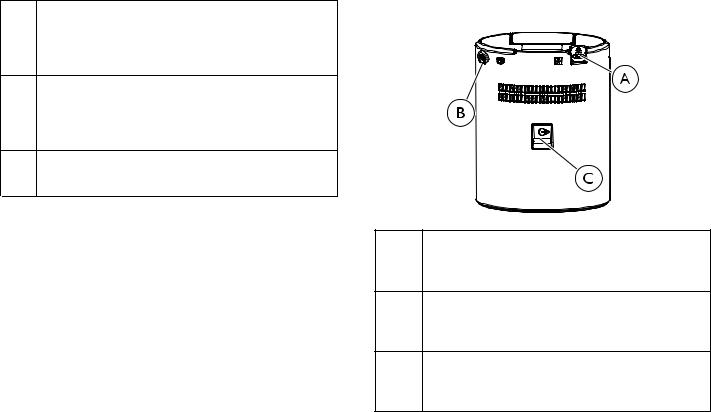
Battery Gauge
GIndicates the charge status of the battery(s). Refer to Reading the Battery Gauge for Installed and Uninstalled Battery(s) in Setup for more details.
External Power Indicator
HThe orange indicator light next to the plug symbol illuminates when an external power source is connected to the concentrator.
Battery Compartment Door
I
Used to access the removable battery(s).
|
Audible Signal (Beep) |
|
Not |
Indicates a change in operating status or |
|
Shown |
||
a condition which requires the operator’s |
||
|
||
|
attention. |
|
|
|
General
1.6.2Input/Output Connections
AOxygen Outlet Port
Used to connect the nasal cannula to the concentrator.
BExternal Power Input Connector
Used to connect an external power source to the concentrator.
CUSB Port
Used for service. Location of POC1–CONNECT Dongle.
1.6.3Filters
Air enters the concentrator through an air intake filter located on the carry bag. This filter prevents hair and other large particles in the air from entering the unit. Before you
1194969-C |
13 |

Invacare® Platinum® Mobile
operate the concentrator, make sure this filter is clean and dry, and the concentrator is properly installed in the carry bag.
To clean the air intake filter, refer to Cleaning the Air Intake Filter Screen in Maintenance.
To ensure the concentrator is properly installed in the carry bag, refer to Installing the Carry Bag in Setup.
1.6.4 Power Options
WARNING!
Risk of Injury or Damage
To avoid injury or damage which will void warranty:
– Use only Invacare specified power supplies.
Battery(s): Up to two rechargeable batteries can be installed in the battery compartment of the concentrator. When fully charged, a single battery supplies power for up to five hours (up to ten hours for two batteries). Visible and audible alarm signals occur when the battery power is getting low. Refer to Alarm Conditions in Troubleshooting and Charging the Battery(s) in Setup.
AC Power Adapter: An AC power adapter allows the concentrator to be connected to a 100–240 volt 50–60 hertz outlet. Use of the AC power adapter will allow the concentrator to operate and simultaneously recharge the installed battery. Refer to Charging the Battery(s) in Setup.
DC Power Cable: A DC power cable allows the concentrator to be connected to an automobile’s (boat, motor home, etc.) 12-volt DC outlet. Use of the DC power cable will allow
the concentrator to operate and simultaneously recharge an installed battery(s). Refer to Charging the Battery(s) in Setup.
1.6.5Carry Bag
The carry bag provides a convenient means to hold the concentrator while performing daily activities.
It can be configured as a messenger bag or backpack using the shoulder straps provided. Refer to Installing the Carry Bag in Setup.
1.7 Optional Accessories and Replacement Parts
The following optional accessories are available from Invacare:
•Additional batteries, model number: POC1–110
•External battery charger with power supply: POC1–115
The following replacement parts are available from Invacare:
•Battery, model number: POC1–110
•Carry Bag, model number: POC1–150
•DC power cable, model number: POC1–140
•AC power adapter with power cord: POC1–130
•USB Dongle, model number: POC1–CONNECT
These parts are base models. Please contact Invacare or your provider for country specific models.
14 |
1194969-C |
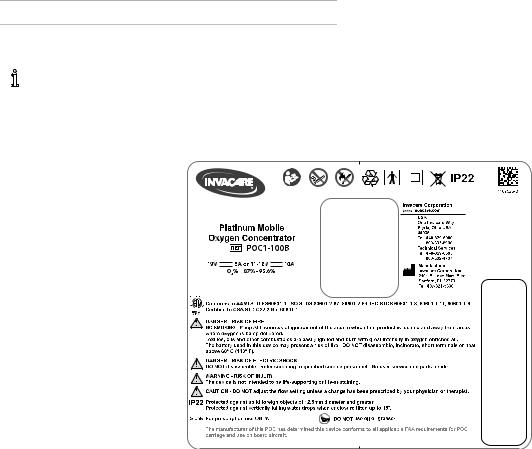
Safety
2 Safety
2.1 Label Locations
The label is located on the back of the concentrator. The serial number is located on the right side of label shown here.
Model POC1-100B
The concentrator has four pulse flow settings.
1194969-C |
15 |
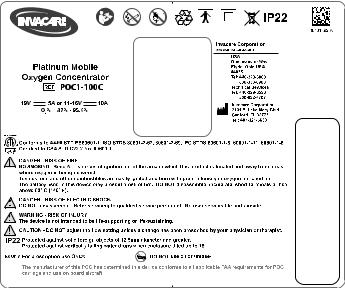
Invacare® Platinum® Mobile
Model POC1-100C
The concentrator has five pulse flow settings.
16 |
1194969-C |

2.2 General Guidelines
In order to ensure the safe installation, assembly and operation of the concentrator these instructions MUST be followed.
DANGER!
Risk Of Death, Injury Or Damage
Improper use of the product may cause death, injury or damage. This section contains important information for the safe operation and use of this product.
–DO NOT use this product or any available optional equipment without first completely reading and understanding these instructions and any additional instructional material such as user manuals, service manuals or instruction sheets supplied with this product or optional equipment.
–If you are unable to understand the warnings, cautions or instructions, contact a health care professional, dealer or technical personnel before attempting to use this equipment.
–Check ALL external components and carton for damage. In case of damage, or if the product is not working correctly, contact a technician or Invacare for repair.
–This product is intended to be used by adults only after reading and understanding the instructions and warnings of this user manual.
–THE INFORMATION IN THIS DOCUMENT IS SUBJECT TO CHANGE WITHOUT NOTICE.
Safety
DANGER!
Risk of Death, Injury Or Damage From Fire
Textiles, oil or petroleum substances, grease, greasy substances and other combustibles are easily ignited and burn with great intensity in oxygen enriched air and when in contact with oxygen under pressure. Smoking during oxygen therapy is dangerous and is likely to result in burns or death. To avoid fire, death, injury or damage:
–DO NOT SMOKE while using this device. DO NOT use near OPEN FLAME or IGNITION SOURCES.
–NO SMOKING signs should be prominently displayed.
–Keep all open flames, matches, lighted cigarettes, electronic cigarettes or other sources of ignition at least 10 ft (3 m) away from this concentrator or any oxygen carrying accessories such as cannulas or tanks.
–If you disregard these warnings about the severe hazard of oxygen use while you continue to smoke, you must always turn off the concentrator, remove the cannula and then wait ten minutes before smoking or leave the room where either the concentrator or any oxygen carrying accessories such as cannulas or tanks are located.
–DO NOT SMOKE while using the concentrator.
1194969-C |
17 |

Invacare® Platinum® Mobile
CAUTION!
Federal (statutory) law restricts this device to sale by or on the order of a medical practitioner licensed by a governmental agency where he/she practices.
–ONLY a licensed medical practitioner may order the purchase or use of this device.
DANGER!
Risk of Death, Injury Or Damage From Fire
Textiles, oil or petroleum substances, grease, greasy substances and other combustibles are easily ignited and burn with great intensity in oxygen enriched air and when in contact with oxygen under pressure. To avoid fire, death, injury or damage:
–Avoid creation of any spark near oxygen equipment. This includes sparks from static electricity created by any type of friction.
–Use only oxygen compatible water-based lotions or salves before and during oxygen therapy. To verify, refer to the lotion/salve container for oxygen compatible water-based statement. If necessary, contact the manufacturer. DO NOT use any lubricants on concentrator unless recommended by Invacare.
–Keep the oxygen tubing, cord, AC adapter, and concentrator out from under such items as blankets, bed coverings, chair cushions, clothing, and away from heated or hot surfaces including space heaters, stoves, and similar electrical appliances.
–Make sure concentrator is off when not in use.
18 |
1194969-C |

CAUTION!
Risk of Minor Injury or Discomfort
It is important to plan ahead for travel and other situations in which you may not have access to additional oxygen or power supplies. To prevent oxygen deprivation:
–Carry supplemental batteries with you.
–Stow the concentrator properly during travel. For proper storage instructions when travelling refer to the travel guide.
WARNING!
Risk of Injury or Damage
To prevent injury or damage from misuse:
–NEVER leave concentrator unattended when connected to power.
–Make sure concentrator is off when not in use.
–Outdoor use MUST be conducted with internal battery power only.
WARNING!
Risk Of Injury Or Damage
–Invacare products are specifically designed and manufactured for use in conjunction with Invacare provided or Invacare specified accessories. Any other accessories have not been tested by Invacare and are not
recommended for use with Invacare products.
–No modification of this equipment is allowed.
Safety
CAUTION!
Risk of Minor Injury or Discomfort
A change in altitude may affect total oxygen available to you. To prevent oxygen deprivation:
–Consult your physician before traveling to higher or lower altitudes to determine if your flow settings should be changed.
DANGER!
Risk of Death, Injury, from Electric Shock
To reduce the risk of burns, electrocution, death or injury to persons:
–DO NOT disassemble. Refer servicing to qualified service personnel. There are no user serviceable parts.
–Avoid using while bathing. If continuous usage is required by the physician's prescription, the concentrator must be located in another room at least 7 ft (2.5 m) from the bath.
–DO NOT come in contact with the concentrator while wet.
–DO NOT place or store concentrator where it can drop into water or other liquid.
–DO NOT reach for concentrator that has fallen into water. Unplug IMMEDIATELY.
–DO NOT block access to power outlet needed to unplug the AC power cord.
–DO NOT use frayed or damaged power cords.
–DO NOT use AC power adapter if its housing is cracked or separated.
1194969-C |
19 |

Invacare® Platinum® Mobile
WARNING!
Risk of Injury or Death
To prevent injury or death from product misuse:
–Closely supervise when this concentrator is used by impaired individuals or near children and/or impaired individuals.
–Monitor patients using this device who are unable to hear or see alarms or communicate discomfort.
CAUTION!
Risk of Minor Injury or Discomfort
While Invacare strives to produce the best oxygen concentrator in the market today, this oxygen concentrator can fail to produce oxygen due to power failure or device malfunction.
–ALWAYS have a backup source of oxygen readily available.
–In the event the concentrator fails to produce oxygen, the concentrator will briefly alarm signaling the patient to switch to their backup source of oxygen. Refer to Troubleshooting for more detail.
–Invacare recommends keeping at least one battery installed in the concentrator even when operating from an external power source.
WARNING!
Risk of Death, Injury or Damage
To prevent injury or damage from cord misuse:
–DO NOT move or relocate concentrator by pulling on the cord.
–DO NOT use extension cords with AC power adapters provided.
–Properly store and position electrical cords and/or tubing to prevent a tripping and strangulation hazards.
WARNING!
Risk of Injury or Damage
To prevent injury or damage during use:
–If you feel ill or uncomfortable, or if the concentrator does not signal an oxygen pulse and you are unable to hear and/or feel the oxygen pulse, consult your equipment provider and/or your physician IMMEDIATELY.
–For optimum performance, Invacare recommends that each use of the concentrator be a minimum of 30 minutes. Shorter periods of operation may reduce maximum product life.
–The concentrator should be used in an upright position.
–The concentrator cannot be used in conjunction with PAP, Bi-Level, mechanical ventilator or other such devices.
20 |
1194969-C |

CAUTION!
Risk of Minor Injury, Discomfort or Damage
–Use of this device at an altitude above 10,000 ft (3048 m) or outside a temperature of 41°F to 104°F (5°C to 40°C) or a relative humidity above 90% is expected to adversely effect the flowrate and the percentage of oxygen and consequently the quality of therapy.
WARNING!
Risk of Injury or Damage
As a safety feature, this appliance may have a polarized plug (one blade is wider than the other). To avoid injury or damage from electrical shock:
–This plug will fit in a polarized outlet only one way. If the plug does not fit fully in the outlet, reverse the plug. If it still does not fit, contact a qualified electrician.
–DO NOT alter the plug in any way.
–DO NOT use if the cord or plug are damaged. Call a qualified electrician for repair.
Safety
CAUTION!
Risk of Damage
To prevent damage from temperature variations:
–DO NOT operate in temperatures below 41°F (5°C) or above 104°F (40°C).
–When your automobile is turned off, disconnect the car accessory power cord and remove
the concentrator from the automobile. DO NOT store the concentrator in a very hot or cold automobile or in other similar, high or low, temperature environments. Refer to Specifications in Technical Data.
WARNING!
Risk of Injury or Damage
To prevent damage from liquid ingress:
–If the concentrator is not working properly, if it has been dropped or damaged, or dropped into water, call equipment provider/qualified technician for examination and repair.
–NEVER drop or insert any object or liquid into any opening.
–Invacare recommends the concentrator not be used in the rain.
–The concentrator is not designed to be used with a humidifier. Use of this device with a humidifier may impair performance and/or damage the equipment.
–DO NOT use if cabinet of concentrator or housing of AC power adapter is cracked or separated.
1194969-C |
21 |

Invacare® Platinum® Mobile
2.3 Radio Frequency Interference
Medical Electrical Equipment needs to be installed and used according to the EMC information in this manual.
This equipment has been tested and found to comply with EMC limits specified by IEC/EN 60601-1-2. These limits are designed to provide a reasonable protection against electromagnetic interference in a typical home health care environment.
Portable and mobile RF communications equipment can affect the operation of this equipment. Use of this equipment adjacent to or stacked with other equipment should be avoided as it could result in improper operation. The concentrator operation should be observed to verify normal operation in the presence of such equipment.
Other devices may experience interference from even the low levels of electromagnetic emissions permitted by the above standards. To determine if the emissions from the concentrator are causing the interference, turn the
concentrator off. If the interference with the other device(s) stops, then the concentrator is causing the interference. In such rare cases, interference may be reduced or corrected by one of the following measures:
•Reposition, relocate, or increase the separation between the equipment.
•Connect the equipment into an outlet on a circuit different from that to which the other device(s) is connected.
Refer to Electromagnetic Compliance (EMC) in Technical Data for additional information.
2.4 Traveling with the Concentrator
Before Traveling
1.Contact your travel carrier and/or tour guide about your travel plans and provide information about your intent to use a portable oxygen concentrator during your travels. The carrier will let you know if you will be permitted to use your concentrator during your travel and if there are any restrictions for use.
If you are not permitted to use your concentrator on the carrier of choice and still want to take it with you:
•Carry it and any supplemental batteries on board with you.
•Ensure the unit is turned off.
•Stow it properly for the trip.
•DO NOT place the concentrator or any supplemental batteries in checked baggage.
2.Contact the carrier to see if they have seats with a power outlet that you can use to power the concentrator during travel. If a power outlet is not available, be sure to bring enough supplemental batteries to last 150% of the travel time.
There may be unexpected delays beyond scheduled travel times. Carry your power adapters with you so you can recharge batteries before and after the trip.
22 |
1194969-C |

3.Charge the installed battery of the concentrator and any supplemental batteries fully before you depart, thus extending the operating time of the concentrator during travel. Refer to Charging the Battery(s) in Setup.
4.Ensure the unit is free of all grease, oil, or other petroleum products and that the unit is in good working order, is free of damage, and the air filter is clean. Refer to the Preventative Maintenance Checklist in Maintenance.
5.Contact your oxygen supplier to make arrangements if you need to have backup oxygen at your destination.
Traveling By Air
Arriving at the Airport
1.Allow the security agent to inspect your concentrator, even if you are using it, when going through the security checkpoint.
They are required to allow you to travel through the checkpoint with your concentrator, but they MUST inspect it for security reasons.
2.Use your AC power adapter while you are in the airport, if possible. This will keep the battery(s) at full charge and give you the most battery powered operating time on the aircraft.
Boarding the Plane
You are not permitted to sit in an exit row if you plan to use your concentrator at any time during the flight.
Safety
1.If you plan on using the concentrator the entire time you are on the plane, verify that your concentrator does not block access to an emergency exit or aisle way. If it does, request a seat change.
2.In order for the flight crew to ensure the safety of you and all of the other passengers on the flight, allow them to inspect the concentrator to confirm that it is FAA approved for use on the flight.
3.If you are not planning to use your concentrator during taxi, takeoff, or landing, you MUST store it in an approved storage area so it does not block the row or aisle access.
Contact the flight crew about location of approved storage areas.
On the Plane
You MUST store the supplemental battery either securely connected to the concentrator or in your carry-on baggage. The supplemental battery MUST be protected from damage and shorting out the external power connector.
1194969-C |
23 |

Invacare® Platinum® Mobile
1.You may use your concentrator when moving about the cabin, ONLY after the pilot turns off the “Fasten Seat Belt” sign.
2.Turn off the unit if the concentrator alarms during the flight, unless the alarm resets itself. If the alarm does not reset, the concentrator MUST be turned off and stored in an approved storage area.
3.If an AC power outlet with a minimum 100W capacity is available on the flight, perform the following:
a.Connect the power adapter to the concentrator.
b.Plug in the power adapter into the airline power outlet.
c.Turn the unit on.
If you have any trouble making the connections to the plane’s power outlet, contact the flight crew for assistance.
After the Flight
1.Ensure you have enough power to run your concentrator while leaving the airport. Recharge the battery(s), if necessary. Refer to Charging the Battery(s) in Setup.
2.Contact your medical gas supplier to obtain your backup oxygen supply, if necessary.
Traveling by Boat
Contact the cruise line and inform them you are traveling with a concentrator. There should be no restrictions on your use of the concentrator during your travel, but it is wise to check with them ahead of time. Power should be available for use of your AC power adapter during your travels, but check first.
Traveling by Train
Contact the train authorities at least twelve hours ahead of arrival that you are going to use your concentrator. There should be no restrictions on your use of the concentrator, but power on the train may not be available for your use during travel times. Ensure there is enough battery life for your trip before you leave.
Traveling by Bus
Contact the bus line about using a concentrator. There should be no restrictions on your use of the concentrator during your trip, but power may not be available for your use during travel times. Ensure there is enough battery life for your trip before you leave.
Traveling by Car
There should be no restrictions on your use of the concentrator during your trip, but power may not be available for your use during travel times. Ensure there is enough battery life for your trip before you leave.
24 |
1194969-C |

3 Setup
3.1 Unpacking
1.Check for any obvious damage to the carton or its contents. If damage is evident, notify the carrier or your local dealer.
2.Remove all loose packing from the carton.
3.Carefully remove all the components from the cartons. The Invacare concentrator’s packaging contains the following items (as shown below) in addition to this user manual. If any parts are missing, please contact your equipment provider.
•Concentrator (Model POC1–100B) with carry bag (Model POC1–150) installed
•Cannula (Westmed #0194)
•Two shoulder straps (Part Number 1187483)
•Battery (Model POC1–110)
•AC power adapter (Part Number 1187452)
•AC power cord (Part Number 1187454 for model POC1–100B)
•DC power cable (Model POC1–140)
Retain all containers and packing materials for storage or return shipment.
3.2 Inspection
Inspect/examine exterior of the oxygen concentrator and accessories for damage. Inspect all components. If damage is found, DO NOT use concentrator. Contact your provider for service and/or repair or for assistance with the setup procedure and to report unexpected operation or events.
Setup
3.3 Powering the Oxygen Concentrator
WARNING!
Risk of Injury or Damage
To avoid injury and damage that will void the warranty:
–Use only Invacare specified power supplies with the oxygen concentrator.
–Prior to using the DC power cable, the automobile (boat, motor home, etc.) engine should be running in order to either operate or charge the oxygen concentrator.
IMPORTANT
The concentrator will not turn on unless the battery is charged.
–Connect AC power to the concentrator and allow battery to fully charge prior to first use.
The oxygen concentrator allows the freedom to choose from the following power sources to enable use both inside and outside of the home:
•Rechargeable battery(s)
•AC power outlet
•12 volt DC power cable
1194969-C |
25 |
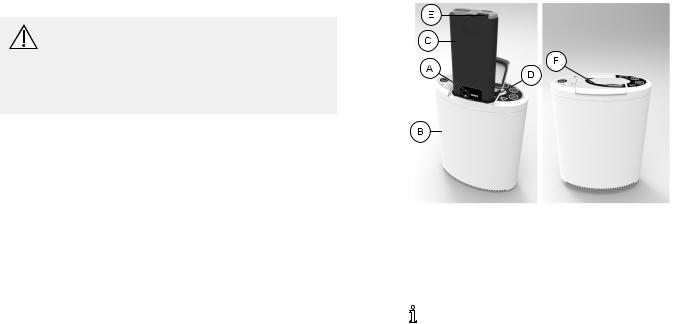
Invacare® Platinum® Mobile
3.3.1 Installing the Battery(s)
DANGER!
Risk of Death, Injury or Damage
To avoid death, injury or damage from fire:
–DO NOT heat above 140°F (60°C), incinerate, disassemble, or short terminals.
–Dispose in accordance with all local regulations.
The oxygen concentrator comes equipped with a single rechargeable lithium battery. Up to two batteries can be installed in the concentrator. When fully charged, a single battery supplies power for up to five hours, depending on the pulse flow setting. Two batteries can supply power for up to ten hours when fully charged, depending on the pulse flow setting.
A battery can be installed while the concentrator is operating from an external power source or a second charged battery.
1.Open the battery compartment door F.
2.With battery fuel gauge label A facing toward the front of the oxygen concentrator B, slowly lower battery C straight down into one of the two slots in the battery compartment D.
Use the lift ring E to hold the battery while installing it.
The battery will not fit properly in the battery compartment if not oriented as described above.
26 |
1194969-C |

3.Ensure the battery fully engages the battery connections located at the bottom of the battery compartment. When fully inserted, the top of the battery is level with the top edge of the battery compartment.
CAUTION!
Risk of Damage
To avoid damage to battery connections from excessive force or misuse:
–DO NOT slam or force battery(s) into place.
–Orient the battery(s) as described in the instructions prior to installing.
To avoid damage to the battery door from excessive force or misuse:
–DO NOT lift concentrator using the battery door.
–Make sure battery(s) are fully installed before closing this battery door.
–DO NOT use concentrator with battery door open.
4.If a second battery is being used (sold separately), install it in the same manner in the unoccupied battery slot.
5.Close the battery compartment door F.
3.3.2 Charging the Battery(s)
Initial Charging of the Battery(s)
Using the concentrator for the first time requires the battery(s) to be charged. Batteries are shipped in a “sleep” mode and an initial charge cycle is required to “wake”
Setup
up the batteries. To charge the battery(s), perform the following steps:
1.Install the battery. Refer to Installing the Battery(s) in Setup.
2.Connect AC power to the concentrator. Refer to External AC Power in Setup.
3.Monitor the battery charge level and charge until full. Refer to Battery Gauge for Installed and Uninstalled Battery(s) in Setup.
4.Disconnect the AC power adapter from the concentrator for portable operation.
IMPORTANT
A concentrator will not turn on unless the battery is charged.
–Connect the AC power to the concentrator and allow battery to fully charge prior to first use.
–Refer to Specifications in Technical Data for approximate charge times.
Charging the Battery(s) After Initial Charging
The installed battery(s) can be charged whether the concentrator is on or off.
1194969-C |
27 |
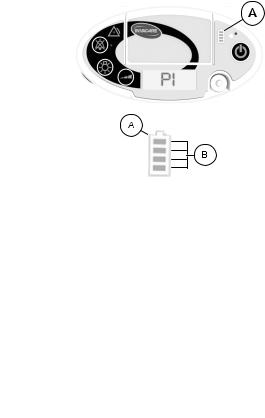
Invacare® Platinum® Mobile
1.For charging of the battery(s) after initial charging, do one of the following:
•Connect the AC power adapter (if charging from a wall outlet). Refer to External AC Power in Setup.
•Connect the DC power cable (if charging from a vehicle). Refer to External DC Power in Setup.
•Remove battery and charge with the optional External Battery Charger accessory, Model POC1–115.
2.Monitor the battery charge level and charge until full. Refer to Battery Gauge for Installed and Uninstalled Battery(s) in Setup.
3.Disconnect external power from the concentrator for portable operation.
3.3.3 Reading the Battery Gauge for Installed and Uninstalled Battery(s)
Battery Gauge for Installed Battery(s)
The battery gauge A shows the status of the installed battery charge level when the concentrator is turned on and when the concentrator is off but connected to an external power source. The number of illuminated segments B
of the battery gauge A indicates the charge level of the installed battery. If two batteries are installed the indicated charge level is that of the least charged battery.
Number of Lit Segments B |
Charge Level |
|
|
1 |
0–25% charge |
|
|
2 |
26–50% charge |
|
|
3 |
51–75% charge |
|
|
4 |
76%-100% charge |
|
|
When the concentrator is connected to an external power source (whether the concentrator is turned on or off) the “last” or “highest” segment B of the battery gauge A also
28 |
1194969-C |
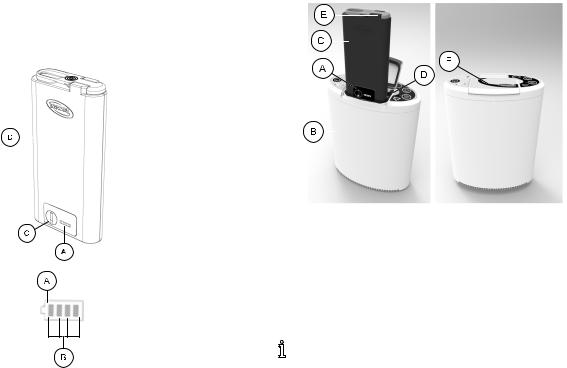
Setup
flashes to show the battery is charging. When the battery is |
3.3.4 Removing the Battery(s) |
||||||||
fully charged, the fourth segment B of the battery gauge A |
|
|
|
|
|
|
|
||
stops flashing and remains lit. |
|
|
|
|
|
|
|
||
Battery Gauge for Uninstalled Battery(s) |
|
|
|
|
|
|
|
||
|
|
|
|
|
|
|
|||
|
|
|
|
|
|
|
|
|
|
|
|
|
|
|
|
|
|
|
|
When the battery D is removed from the concentrator, press the battery status button C to show the status of the charge level on the battery gauge A. Refer to the charge level B table in Reading the Battery Gauge for Installed and Uninstalled Battery(s) in Setup.
1.Open the battery compartment door F of the concentrator B.
2.Pull straight up on the lift ring E to remove the battery C from the battery compartment D.
3.If a second battery is being used (sold separately), remove it in the same manner.
4.Close the battery compartment door.
A steady audible beep will occur when all power sources are removed from the concentrator. Refer to Shut Down Alarms in Troubleshooting.
A battery can be removed without affecting the operation of the concentrator as long as an external power source or a second charged battery is installed.
1194969-C |
29 |
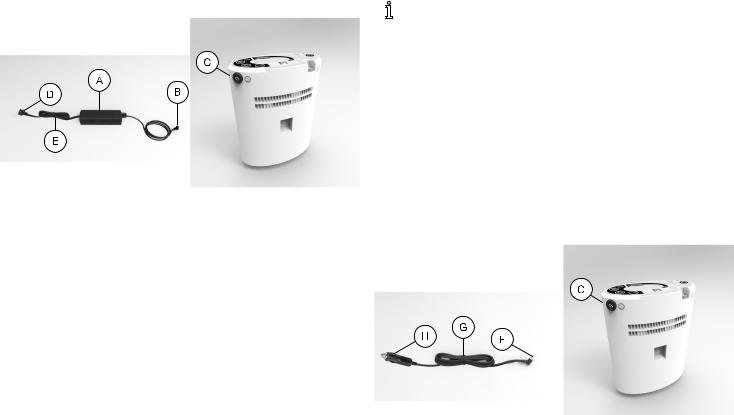
Invacare® Platinum® Mobile
3.3.5 External AC Power
The AC power adapter A allows the oxygen concentrator to be connected to a 100–240 volt 50–60 Hertz outlet (i.e. wall outlet of your home). The power adapter converts AC voltage to a DC voltage that can be used to power the oxygen concentrator. Use of the AC power adapter will allow the oxygen concentrator to operate and simultaneously recharge the battery(s).
Complete the following steps to connect the AC power adapter to the concentrator:
1.If not already assembled, attach the AC power cord E to the AC power adapter A.
2.Insert the AC power adapter outlet connector B into the external power input connector C of the concentrator.
3.Insert plug D into an AC outlet.
The external power input connector of the concentrator is angled slightly upward. The outlet connector of the power cord needs to be angled slightly upward when installed.
When a battery is installed, external AC or DC power can be connected or disconnected whether the concentrator is off or on.
When an external power source is properly connected to the concentrator, the orange indicator light next to the plug symbol on the control panel will illuminate and there will be an audible beep. When external power is disconnected, the orange light will turn off and there will be an audible beep.
3.3.6External DC Power
The DC power cable G allows the oxygen concentrator to be connected to an automobile’s (boat, motor home, etc.) 12–volt DC outlet. Use of the DC power cable will allow
30 |
1194969-C |
